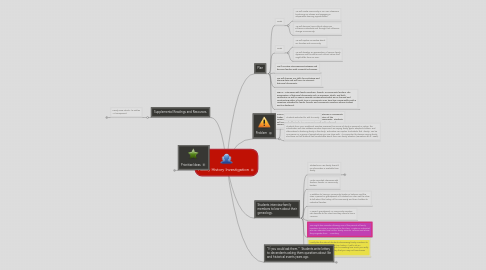
1. Supplemental Readings and Resources.
1.1. Family Tree Charts - to add an Art component.
1.1.1. I am sure we read the same book and I am doing a similar project. For art they can do a family shield, a family quilt, self or family portraits. Also they can do a recipe cook book. (I think the cookbook would be really fun and of course you can try out recipes as well!) Monica
2. Prioritize Ideas
2.1. Investigate Family History and Write about the experience.
2.2. Investigate Historical Events / how family was affected.
2.3. Learn to read official documents of history. Birth Certificates, Marriage Certificates, Land Records...
2.4. I really like the ideas that you have for this section. I am slightly confused exactly what you mean by "prioritize ideas" though. I really like the task of investigating students family history. Have you considered having the students either bringing in significant pictures or objects that represent their families or maybe even having each student draw/explain things that best describe their families.-Holly K.
3. Plan
3.1. Goals
3.1.1. We will create community in our own classroom by sharing our stories and engaging in cooperative learning opportunities.
3.1.2. We will discover how cultural values can influence individuals and through that influence, change a community.
3.2. Goals
3.2.1. We will explore curiosities about our families and community.
3.2.2. We will develop an appreciation of various family dynamics and the ethnic and cultural values that might differ from our own.
3.3. We’ll practice interviewing strategies and become familiar with research techniques.
3.4. We will sharpen our skills for evaluating and sharing data and will learn to interpret historical documents.
3.5. IDEAS: Interviews with family members, friends, or community leaders; The examination of historical documents such as marriage, death, and birth certificates as well as census records; Writing about what we've learned and constructing either a family tree or community even time-line; Going public with a reception attended by family, friends, and community members where student work is displayed.
3.6. SOCIAL ACTION: Students will invite a local historian or community leader to the classroom and learn about the history of the community as well as the current needs in the community. Students will respond collectively to a community need with a planned campaign to help.
4. Problem
4.1. Students Reluctant to Talk to Family
4.1.1. If this occurs, students would possibly write down the interview questions and then simply hand hem to their family members or friends and have them write the answers instead of a formal interview. -Courtney
4.2. Students from Non-Traditional Families: Because this course of study is personal in nature, the introduction will also address sensitive topics such as varying family types, adopted children, and alternatives to featuring family in the study. Educators can explain to students that “family” can be one person or a group of people whom you are close with. It is important to discuss varying family structures so that students feel comfortable about their own family situation (Zemelman et al., 2000).
5. Students interview family members to learn about their geneology.
5.1. Students can use family friend if no information is available from family.
5.1.1. Sub Idea 1
5.1.2. Sub Idea 2
